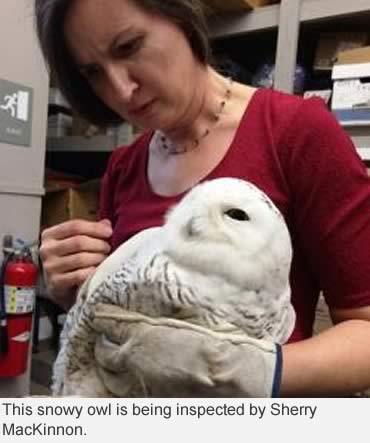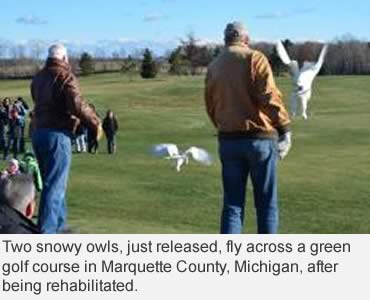From Saginaw Bay to Sault Ste. Marie to Kalamazoo, people across Michigan this winter have reported an influx of snowy owls far, far from their Arctic tundra home. These beautiful white birds, with piercing yellow eyes and nearly 5-foot wingspans, are North America's largest owls, averaging between 3.5 and 6.5 pounds in weight.
Snowy owls are raptors, protected by federal law, and are diurnal in nature. They hunt for food during day and night. Why the owls unpredictably travel so far south, in massive movements known as irruptions, is not well understood by wildlife biologists. What is known is that their behavior can be linked to weather, food supply, and the number of chicks the owls produce in a given year.
By the time snowy owls arrive in Michigan they are often weakened, starving, dehydrated and infested with mites. Others die along extended flight paths which have taken them as far south this winter as Kansas, along the northern tier states, to the Great Lakes and east to the Gulf of Saint Lawrence. When owls appear, Michigan’s Department of Natural Resources receives calls reporting snowy owl sightings, especially for owls that appear sick or injured. In October 2015, many of those calls came from the Upper Peninsula.
 "When we receive a call regarding an injured snowy owl, we will either have the caller drop the bird off at the DNR office or we will pick up the bird," said Erin Largent, a research wildlife technician at Marquette. "We then take the injured bird to the Gwinn-Sawyer Veterinary Clinic." The veterinary assesses damage to the owl, then treats the owl and transports it to a rehabilitator, or euthanizes the bird if its injuries are too severe. On October 19, Jerry Maynard and Bob Jenson, cofounders of the Chocolay Raptor Center in Harvey, rescued a snowy owl from a municipal compost facility in Marquette.
"When we receive a call regarding an injured snowy owl, we will either have the caller drop the bird off at the DNR office or we will pick up the bird," said Erin Largent, a research wildlife technician at Marquette. "We then take the injured bird to the Gwinn-Sawyer Veterinary Clinic." The veterinary assesses damage to the owl, then treats the owl and transports it to a rehabilitator, or euthanizes the bird if its injuries are too severe. On October 19, Jerry Maynard and Bob Jenson, cofounders of the Chocolay Raptor Center in Harvey, rescued a snowy owl from a municipal compost facility in Marquette.
"We got a call that it couldn't fly and did not look healthy," Maynard said. "It was seriously underweight and emaciated, and we could find no other injuries." However, the owl was heavily infested with mites. Maynard sprayed the bird to remove mites and began treatments for dehydration. During the first 24 hours, snowy owls being rehabilitated are tube-fed a special formula with easily digestible proteins and sugars. As owls recover, they eat frozen mice, rats, chicks and quail. If all goes well, the owls are released back into the wild, often within a few weeks. Sightings of owls continued throughout Michigan as 2015 came to a close, including a November 23 report of a snowy owl sitting on the arm of a lamp post on the Mackinac Bridge. Snowy owls hunt over open territory and often will sit on telephone poles, light standards, buildings or small knolls or berms.
With the increase in snowy owl activity, the DNR’s Wildlife Disease Laboratory in Lansing has been helping researchers with Project SNOWstorm determine the potential effects of the owls’ southward journeys.
Project SNOWstorm and other snowy owl research efforts emerged during the massive irruption in the winter of 2013-14, when snowy owls were recorded as far south as Florida and as far west as Hawaii. A smaller, but substantial, irruption has followed, but even during nonirruptive years, a few snowy owls generally wing their way to Michigan. The goal of Project SNOWstorm is to quickly follow snowy owl movements, using cutting-edge tracking technology while working with researchers. Live owls are tracked with solar-powered GPS transmitters.
 Visitors to the website can currently follow the movements of four snowy owls captured and fitted with tracking devices in early 2015 in Michigan.
Visitors to the website can currently follow the movements of four snowy owls captured and fitted with tracking devices in early 2015 in Michigan.
"While it might be the case that a small proportion of the owls that disperse are underweight or malnourished, researchers who study these irruptions actually report that the birds that come south during major irruptions are fatter and healthier than birds that wander during non-irruptive years," Maynard said. Maynard encourages anyone who spots a snowy owl to use caution before judging it to be too weak to fly or to be incapacitated in some way. "Please resist the urge to try to catch these birds or to approach them too closely," Maynard said. "It is far more likely that a quiet, unassuming snowy owl is just being a normal snowy owl." As spring arrives, snowy owls make their way back north to the Arctic. Watch a video of Maynard and Jensen releasing two rehabilitated snowy owls at a golf course in Marquette County here.
— From the Michigan Department of Natural Resources
— Photos courtesy Michigan Department of Natural Resources